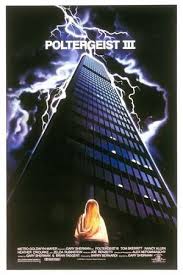
POLTERGEIST III
US, 1988, 98 minutes, Colour.
Tom Skerritt, Nancy Allen, Heather O’ Rourke, Zelda Rubinstein, Lara Flynn Boyle.
Directed by Gary Sherman.
Poltergeist III followed two years after Poltergeist II: The Other Side. The original Poltergeist, produced by Steven Spielberg and directed by Tobe Hooper (The Texas Chainsaw Massacre) was a great commercial success. The sequels were less so – but that was in comparison with the original. Each of them had some strength in themselves.
Director this time is Gary Sherman who made a number of horror films including Death Line in the UK as well as Dead and Buried. The film has a strong cast, especially with Tom Skerritt in the lead. Heather O’ Rourke had appeared as the little girl in the previous two films – and was to suddenly die of an infection after this film was completed. Zelda Rubinstein also appeared in the other films. Lara Flynn Boyle, at the beginning of her career, appears as Tom Skerritt’s daughter.
The film shows the little girl as living with her uncle and aunt, newly married. They are in Chicago where the uncle is in charge of a new modern building. The Reverend Henry Kane, from the previous films, is on a quest to go into the Light and uses the little girl as his medium. This leads to all kinds of poltergeist activity in the building itself – with some interesting special effects, especially the crashing of some snow-covered cars.
The film is familiar material, fans find it very weak in comparison with the original – but those coming on it for the first time may be quite entertained if they enjoy this kind of horror poltergeist film.
1.The series and its popularity in the 1980s? Since?
2.Audience belief in poltergeist activity? Ghosts? Kinetic effects? Destruction? The touch of the supranatural, supernatural, diabolical?
3.The Chicago setting, most of the action confined to the building, its interiors, the rooms, the parking lot, the elevators? The musical score?
4.The situation of Carol Anne, her age, her past experiences? Sent by her parents to her uncle in Chicago? His marrying Patricia? Donna, his daughter? Setting up a family in Chicago? Carol Anne and her worldly wisdom? Vocabulary? The effect of the poltergeists? Her going to the special school, her observing through the one-way mirror? The discussions with Doctor Seaton? Her disappearing? Tangina and the search for her? Carol Anne’s reappearances, on the other side of the mirror, taken possession by Reverend Kane? Her being lost, wanting to be found? The final happy ending?
5.Bruce Gardner, his taking on Carol Anne, his relationship with Donna? The happy family? Marrying Patricia? The building, the opening, the gallery? Social life? His disappearing with Patricia, the incidents in the building, their being pursued, Tangina, her disappearance, Donna’s behaviour, her boyfriend? The mirrors? Up and down the steps? The parking lot and the snow-clad cars? Going through the windows? Disappearances? The happy reuniting?
6.Patricia, love for her husband, for Donna and Carol Anne? Her awkwardness with Carol Anne? At the social, with her husband, being pursued and terrified? The final confrontation, declaration of love for Carol Anne? Going through the mirror? Reunited with her family?
7.Donna, the teenager, preparing to go out, makeup? The party, friendship with Scott? Their being overtaken by the poltergeist? Their destructive aspects and laughing, the death of Doctor Seaton?
8.Doctor Seaton, scepticism, observing Carol Anne? The classroom, the gifted children, the discussions of Chopin? His sessions with Carol Anne, their being observed? The cup crashing into the mirror? His suggestion of mass hypnotism? With Bruce and Patricia? His scepticism? Tangina? His death?
9.Tangina, from the previous films, her supernatural powers, care for Carol Anne? Her disappearance, reappearance? Her decision to save Carol Anne and go with Kane into the Light?
10.The background of this kind of poltergeist horror film? Audience belief and disbelief? Horror thrills?